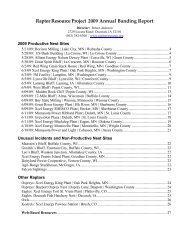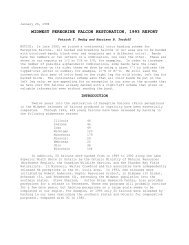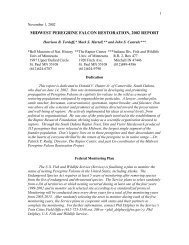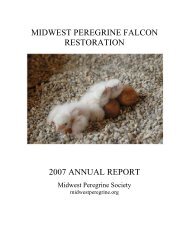2006 - Midwest Peregrine Falcon Restoration Project
2006 - Midwest Peregrine Falcon Restoration Project
2006 - Midwest Peregrine Falcon Restoration Project
You also want an ePaper? Increase the reach of your titles
YUMPU automatically turns print PDFs into web optimized ePapers that Google loves.
36<br />
BLOOD SAMPLES<br />
We continued collecting blood in <strong>2006</strong> from all wild young banded in the U.S., and from<br />
whatever wild breeders were handled. The goal is to provide the research base for measuring<br />
inbreeding, outbreeding, genetic variation, changes in occupancy of territories, dispersal of adults and<br />
young, success of the different genetic stocks introduced, development of genetic structure in the new<br />
<strong>Midwest</strong>ern population, and other topics yet to be determined.<br />
The peregrine blood samples collected over the years uniquely represent the history of the<br />
<strong>Midwest</strong> population. Only a handful of eggs, study skins and skeletons, acquired randomly, have<br />
been preserved, in contrast to the nearly full coverage of blood samples saved. Sophisticated as<br />
current techniques of blood analysis may seem today, they will be considered primitive in a few<br />
years. The blood specimens are in the permanent tissue collections at the Bell Museum of Natural<br />
History, University of Minnesota, where they are available for study now and in the future.<br />
We need to continue to try to:<br />
PLANS FOR THE FUTURE<br />
-Identify all breeders.<br />
-Band all wild young produced<br />
-Collect blood from all young and any adults handled<br />
-Appropriately manage pairs nesting on man-made structures<br />
-Maintain good working relationships with building owners and personnel responsible for public<br />
structures used as nest site<br />
-Monitor the newly-established peregrines on the river cliffs and on suitable cliffs elsewhere in the<br />
region<br />
-Collect, coordinate, and circulate information among <strong>Midwest</strong> peregrine workers through reports<br />
and regular informal contacts<br />
-Develop permanent names and obtain accurate lat/long information for each nesting site<br />
ACKNOWLEDGMENTS<br />
The <strong>Midwest</strong> <strong>Peregrine</strong> <strong>Project</strong> is a cooperative effort involving many people and<br />
organizations. The University of Minnesota provides the overall coordination of the project through<br />
Pat Redig and Jane Goggin of The Raptor Center with continuing advice, encouragement and<br />
unbounded enthusiasm from Bud Tordoff of the Bell Museum of Natural History and the Department<br />
of Ecology, Evolution, and Behavior. We are able to maintain our database on peregrines, which is<br />
the basis of the various reports you receive, through the enthusiastic cooperation of people interested<br />
in peregrines in the 13 U.S. states and two Canadian provinces in our area. The database is available<br />
online to anyone interested at Richard Peifer, Kyle Hammond,<br />
and Bruce Fall make the online database possible. We thank all of you who have sent us information.<br />
We are grateful to those who read parts of an early draft of this report for help in detecting errors and<br />
omissions. Please let us know about mistakes that were missed.








